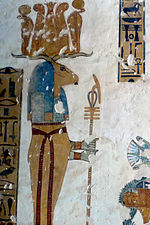| Revision as of 01:48, 21 February 2015 edit166.137.246.64 (talk) Undid revision 648121890 by Ian.thomson (talk)← Previous edit | Revision as of 02:02, 21 February 2015 edit undoA. Parrot (talk | contribs)Extended confirmed users, Pending changes reviewers, Rollbackers32,735 edits Undid revision 648125748 by 166.137.246.64 (talk); sockpuppet.Next edit → | ||
| Line 7: | Line 7: | ||
| Typically Banebdjedet was depicted with four rams' heads to represent the four ]'s of the sun god. He may also be linked to the first four gods to rule over Egypt (], ], ] and Ra-Atum), with large granite shrines to each in the Mendes sanctuary.<ref name="pinch"/> | Typically Banebdjedet was depicted with four rams' heads to represent the four ]'s of the sun god. He may also be linked to the first four gods to rule over Egypt (], ], ] and Ra-Atum), with large granite shrines to each in the Mendes sanctuary.<ref name="pinch"/> | ||
| The '']'' describes the "Ram of Mendes" as being the ''Ba'' of |
The '']'' describes the "Ram of Mendes" as being the ''Ba'' of Osiris but this was not an exclusive association. A story dated to the ] describes him as being consulted by the "Divine Tribunal" to judge between Horus and ] but he proposes that ] do it instead as an act of diplomacy. As the dispute continues it is Banebdjedet who suggests that Seth be given the throne as he is the elder brother.<ref name="pinch"/> | ||
| In a chapel in the ], a stela records how the god ] took the form of Banebdjedet, in view of his virility, in order to have union with the woman who would conceive ]. It was the sexual connotations associated with his cult that led early ] to demonise Banebdjedet.<ref name="pinch"/> | In a chapel in the ], a stela records how the god ] took the form of Banebdjedet, in view of his virility, in order to have union with the woman who would conceive ]. It was the sexual connotations associated with his cult that led early ] to demonise Banebdjedet.<ref name="pinch"/> | ||
Revision as of 02:02, 21 February 2015
| ||||||
| Banebdjedet in hieroglyphs | ||||||
|---|---|---|---|---|---|---|

Banebdjedet (Banebdjed) was an Ancient Egyptian ram god with a cult centre at Mendes. Khnum was the equivalent god in Upper Egypt. His wife was the goddess Hatmehit ("Foremost of the Fishes") who was perhaps the original deity of Mendes. Their offspring was "Horus the Child" and they formed the so-called "Mendesian Triad".
The words for "ram" and "soul" sounded the same in Egyptian so ram deities were at times regarded as appearances of other gods.
Typically Banebdjedet was depicted with four rams' heads to represent the four Ba's of the sun god. He may also be linked to the first four gods to rule over Egypt (Osiris, Geb, Shu and Ra-Atum), with large granite shrines to each in the Mendes sanctuary.
The Book of the Heavenly Cow describes the "Ram of Mendes" as being the Ba of Osiris but this was not an exclusive association. A story dated to the New Kingdom describes him as being consulted by the "Divine Tribunal" to judge between Horus and Seth but he proposes that Neith do it instead as an act of diplomacy. As the dispute continues it is Banebdjedet who suggests that Seth be given the throne as he is the elder brother.
In a chapel in the Ramesseum, a stela records how the god Ptah took the form of Banebdjedet, in view of his virility, in order to have union with the woman who would conceive Rameses II. It was the sexual connotations associated with his cult that led early Christians to demonise Banebdjedet.
Notes
- Hermann Ranke: Die ägyptische Persönennamen. Verlag von J. J. Augustin in Glückstadt, 1935. , p.89
- ^ Handbook of Egyptian mythology, Geraldine Pinch, p 114-115, Oxford University Press, 2004, ISBN 0-19-517024-5
- "Mistress of the House, Mistress of Heaven: women in ancient Egypt", Anne K. Capel, Glenn Markoe, p 72, Cincinnati Art Museum, Brooklyn Museum, Hudson Hills, 1996, ISBN 1-55595-129-5